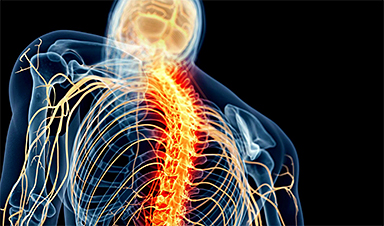A team of researchers from the Institute for Bioengineering of Catalonia (IBEC) has developed light-activated derivatives of the anti-epileptic drug carbamazepine to treat neuropathic pain.
Light can be harnessed to target drugs to specific body areas using photopharmacology. This technique modifies the drug’s chemical structure by incorporating a light-sensitive molecular switch, like azobenzene. As a result, the drug becomes active only under exposure to certain light wavelengths, remaining inactive in the dark.
Based on these principles, a team of researchers led by the Institute for Bioengineering of Catalonia (IBEC) has developed photoswitchable derivatives of carbamazepine, an anti-epileptic drug widely used in medicine to combat some types of neuropathic pain, such as trigeminal neuralgia. These compounds, which have an analgesic effect when activated by light, are able to inhibit nerve signals locally and on demand. The derivatives synthesized by the researchers are activated at wavelengths corresponding to the amber color, which allows them to pass through tissue and bone using conventional halogen lamps.
The two synthesized compounds, carbazopine-1, and carbadiazocine, show photopharmacological activity, allowing the activity of hippocampal neurons and the locomotion of zebrafish larvae to be reversibly controlled by light. These in vivo experiments make it possible to observe anxiety-related behaviors reflected in sudden swimming movements. IBEC researcher Luisa Camerin, the first author of the study, explains: “When we illuminate larvae that have uptaken these compounds with a certain wavelength, the drug is activated and the larvae move faster. If we change the wavelength, their movement slows down again, demonstrating the reversible effect of the compound on the nervous system.
Pain Management Innovations
Carbadiazocine has also been shown to have analgesic properties: “In rat models developed in the laboratory of Esther Berrocoso at the University of Cadiz, we have observed that carbadiazocine has an analgesic effect on neuropathic pain without any signs of anesthesia, sedation or toxicity. These results demonstrate a simple and convincing treatment with non-invasive illumination,” explains Pau Gorostiza, ICREA research professor, principal investigator at IBEC, and member of CIBER-BBN.
Neuropathic pain is caused by lesions or diseases of the somatosensory system, such as lumbar radiculopathy (“sciatica”), diabetic neuropathy, and chronic post-operative pain. The treatment of this type of pain often requires opioids, which are stronger analgesics than the usual NSAIDs – such as paracetamol and ibuprofen. However, their use is controversial due to their inconsistent efficacy, the need for high doses that can lead to tolerance and addiction, and systemic side effects such as constipation, nausea, dizziness, and drowsiness.
In this context, light-based therapies are becoming increasingly important in medicine because of their ability to target specific regions of the body, increasing treatment efficacy and reducing the side effects of systemic drugs.
The team is already working on the next step in this project, which will involve activating drugs using infrared light, which penetrates deeper into tissue, and using portable light sources such as lasers or light-emitting diodes (LEDs).
Reference: “Photoswitchable carbamazepine analogs for non-invasive neuroinhibition in vivo” by Luisa Camerin, Galyna Maleeva, Alexandre Gomila-Juaneda, Irene Suárez-Pereira, Carlo Matera, Davia Prischich, Ekin Opar, Fabio Riefolo, Esther Berrocoso and Pau Gorostiza, 18 June 2024, Angewandte Chemie International Edition.
DOI: 10.1002/anie.202403636
This study is part of the PHOTOTHERAPORT project, coordinated by the Institute for Bioengineering of Catalonia (IBEC). The project is funded by the prestigious Pathfinder Open program of the European Innovation Council (EIC) and focuses on the development of luminescent implants and light-activated drugs for innovative neuromodulation therapies (HORIZON-EIC-2023 program PATHFINDEROPEN-01, no. 101130883). PHOTOTHERAPORT is a consortium of 8 institutions from 4 countries with a budget of 3 million euros over 3 years to carry out the project.
News
Scientists Melt Cancer’s Hidden “Power Hubs” and Stop Tumor Growth
Researchers discovered that in a rare kidney cancer, RNA builds droplet-like hubs that act as growth control centers inside tumor cells. By engineering a molecular switch to dissolve these hubs, they were able to halt cancer [...]
Platelet-inspired nanoparticles could improve treatment of inflammatory diseases
Scientists have developed platelet-inspired nanoparticles that deliver anti-inflammatory drugs directly to brain-computer interface implants, doubling their effectiveness. Scientists have found a way to improve the performance of brain-computer interface (BCI) electrodes by delivering anti-inflammatory drugs directly [...]
After 150 years, a new chapter in cancer therapy is finally beginning
For decades, researchers have been looking for ways to destroy cancer cells in a targeted manner without further weakening the body. But for many patients whose immune system is severely impaired by chemotherapy or radiation, [...]
Older chemical libraries show promise for fighting resistant strains of COVID-19 virus
SARS‑CoV‑2, the virus that causes COVID-19, continues to mutate, with some newer strains becoming less responsive to current antiviral treatments like Paxlovid. Now, University of California San Diego scientists and an international team of [...]
Lower doses of immunotherapy for skin cancer give better results, study suggests
According to a new study, lower doses of approved immunotherapy for malignant melanoma can give better results against tumors, while reducing side effects. This is reported by researchers at Karolinska Institutet in the Journal of the National [...]
Researchers highlight five pathways through which microplastics can harm the brain
Microplastics could be fueling neurodegenerative diseases like Alzheimer's and Parkinson's, with a new study highlighting five ways microplastics can trigger inflammation and damage in the brain. More than 57 million people live with dementia, [...]
Tiny Metal Nanodots Obliterate Cancer Cells While Largely Sparing Healthy Tissue
Scientists have developed tiny metal-oxide particles that push cancer cells past their stress limits while sparing healthy tissue. An international team led by RMIT University has developed tiny particles called nanodots, crafted from a metallic compound, [...]
Gold Nanoclusters Could Supercharge Quantum Computers
Researchers found that gold “super atoms” can behave like the atoms in top-tier quantum systems—only far easier to scale. These tiny clusters can be customized at the molecular level, offering a powerful, tunable foundation [...]
A single shot of HPV vaccine may be enough to fight cervical cancer, study finds
WASHINGTON -- A single HPV vaccination appears just as effective as two doses at preventing the viral infection that causes cervical cancer, researchers reported Wednesday. HPV, or human papillomavirus, is very common and spread [...]
New technique overcomes technological barrier in 3D brain imaging
Scientists at the Swiss Light Source SLS have succeeded in mapping a piece of brain tissue in 3D at unprecedented resolution using X-rays, non-destructively. The breakthrough overcomes a long-standing technological barrier that had limited [...]
Scientists Uncover Hidden Blood Pattern in Long COVID
Researchers found persistent microclot and NET structures in Long COVID blood that may explain long-lasting symptoms. Researchers examining Long COVID have identified a structural connection between circulating microclots and neutrophil extracellular traps (NETs). The [...]
This Cellular Trick Helps Cancer Spread, but Could Also Stop It
Groups of normal cbiells can sense far into their surroundings, helping explain cancer cell migration. Understanding this ability could lead to new ways to limit tumor spread. The tale of the princess and the [...]
New mRNA therapy targets drug-resistant pneumonia
Bacteria that multiply on surfaces are a major headache in health care when they gain a foothold on, for example, implants or in catheters. Researchers at Chalmers University of Technology in Sweden have found [...]
Current Heart Health Guidelines Are Failing To Catch a Deadly Genetic Killer
New research reveals that standard screening misses most people with a common inherited cholesterol disorder. A Mayo Clinic study reports that current genetic screening guidelines overlook most people who have familial hypercholesterolemia, an inherited disorder that [...]
Scientists Identify the Evolutionary “Purpose” of Consciousness
Summary: Researchers at Ruhr University Bochum explore why consciousness evolved and why different species developed it in distinct ways. By comparing humans with birds, they show that complex awareness may arise through different neural architectures yet [...]
Novel mRNA therapy curbs antibiotic-resistant infections in preclinical lung models
Researchers at the Icahn School of Medicine at Mount Sinai and collaborators have reported early success with a novel mRNA-based therapy designed to combat antibiotic-resistant bacteria. The findings, published in Nature Biotechnology, show that in [...]






















